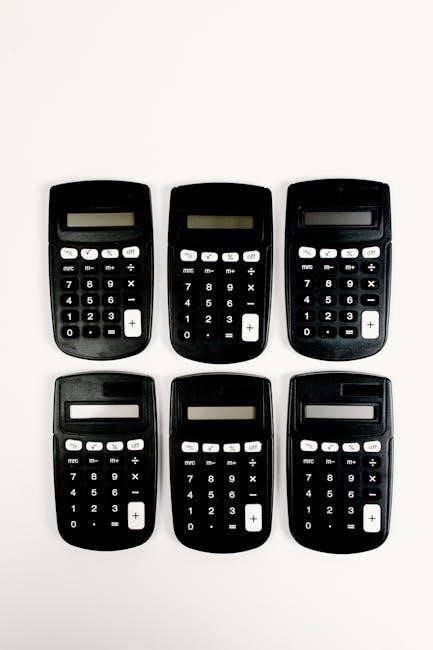Addition and subtraction worksheets are essential tools for mastering basic arithmetic operations. These resources are designed to help students practice and reinforce their understanding of adding and subtracting numbers. Available in PDF format, they offer a convenient way to access exercises anytime, anywhere. Worksheets typically include a variety of problems, such as single-digit, double-digit, and three-digit numbers, with and without regrouping. They cater to different skill levels, from basic addition and subtraction facts to more complex calculations. Many worksheets also incorporate visual aids, like ten frames or number lines, to support learning. By using these materials, students can develop fluency in math, improve problem-solving skills, and build a strong foundation for more advanced concepts. Regular practice with these worksheets ensures steady progress and confidence in arithmetic abilities.

Types of Addition and Subtraction Worksheets
Addition and subtraction worksheets come in a variety of formats to cater to different learning needs and skill levels. These resources are designed to provide targeted practice, ensuring that learners can focus on specific areas of improvement. Below are some of the most common types of addition and subtraction worksheets available in PDF format:
Single-Digit and Double-Digit Worksheets
For beginners, single-digit addition and subtraction worksheets are ideal. These worksheets feature simple problems that involve adding or subtracting numbers from 0 to 9. They are perfect for young learners or those just starting to grasp basic arithmetic. As students progress, double-digit worksheets introduce problems involving two-digit numbers, such as 23 + 45 or 75 ー 32. These problems help students understand place value and basic operations.
Worksheets with Regrouping
Regrouping is a fundamental concept in arithmetic, and worksheets that focus on this skill are essential for building proficiency. Addition with regrouping involves carrying over numbers when the sum exceeds 9, while subtraction with regrouping requires borrowing from the next higher place value. For example, problems like 37 + 19 (which equals 56) or 54 ー 27 (which equals 27) are commonly included in these worksheets.
Three-Digit Addition and Subtraction Worksheets
For more advanced learners, three-digit addition and subtraction worksheets provide challenging exercises. These problems, such as 456 + 279 or 753 ー 421, require students to apply regrouping across multiple place values. They are designed to reinforce mastery of arithmetic operations and prepare learners for more complex math concepts.
Mixed Numbers and Fractions
Addition and subtraction worksheets also cater to learners working with fractions and mixed numbers. These exercises involve problems like 1/2 + 3/2 or 2 1/4 ー 1 3/4. They are particularly useful for students transitioning from basic arithmetic to more advanced mathematical operations.
Algebraic Fractions Worksheets
For older students or those preparing for higher-level math, algebraic fractions worksheets are available. These resources focus on adding and subtracting fractions with variables, providing a structured approach to mastering this challenging topic. They are ideal for GCSE revision and advanced skill-building.
Number Bonds and Mental Math Worksheets
Number bonds worksheets emphasize the relationship between numbers, helping students develop mental math skills. For example, learners might practice adding or subtracting numbers to reach a specific target, such as 100. These exercises enhance fluency and speed in arithmetic calculations.
Ten Frames and Visual Aids

Visual learners benefit from worksheets that incorporate ten frames, number lines, or pictorial representations. These tools help students visualize addition and subtraction processes, making abstract concepts more concrete. For instance, adding different colored dots to ten frames to match an addition question is a popular activity.
Electronic and Interactive Worksheets
In addition to traditional PDF worksheets, electronic versions are available. These interactive tools use software to organize and align math problems, providing a dynamic learning experience. They often include features like automatic scoring and real-time feedback, making practice more engaging and efficient.
Specialized Worksheets for Different Ages
Addition and subtraction worksheets are tailored to meet the needs of various age groups. For younger learners, worksheets might feature colorful illustrations and simple layouts, while older students can access more complex, text-heavy resources. This variety ensures that learners at every stage can find exercises that suit their abilities and interests.

Benefits of Using Addition and Subtraction Worksheets
Addition and subtraction worksheets are invaluable resources for learners of all ages, offering numerous benefits that enhance mathematical understanding and skill development. These tools are designed to provide structured practice, making them an essential component of math education. Below are the key advantages of incorporating addition and subtraction worksheets into learning routines:
Improves Fluency in Basic Arithmetic
Mastering addition and subtraction is the foundation of arithmetic skills. Worksheets provide repetitive practice, helping learners achieve fluency in these operations. Regular use of these resources ensures that students can perform calculations quickly and accurately, a skill critical for more advanced math concepts.
Enhances Problem-Solving Skills
Addition and subtraction worksheets expose learners to a variety of problem types, from simple single-digit exercises to complex multi-digit calculations. This diversity helps students develop critical thinking and problem-solving abilities, enabling them to approach math challenges with confidence.
Reinforces Understanding of Regrouping
Regrouping is a fundamental concept in arithmetic, and worksheets dedicated to this skill ensure that learners grasp it thoroughly. By practicing regrouping in both addition and subtraction, students develop a deeper understanding of place value and how numbers interact during operations.
Develops Mental Math Skills
Worksheets often include exercises that encourage mental math, such as estimating sums or differences before calculating them precisely. This practice sharpens learners’ ability to perform calculations mentally, a valuable skill in everyday life.
Builds Confidence in Math Abilities
Consistent practice with addition and subtraction worksheets fosters a sense of accomplishment and confidence. As learners master each set of problems, they gain the assurance to tackle more challenging math tasks, reducing anxiety and fostering a positive attitude toward mathematics.
Encourages Personalized Learning
Addition and subtraction worksheets are adaptable to individual needs. Learners can focus on specific areas where they require improvement, such as regrouping or mental math, allowing for a tailored learning experience. This flexibility ensures that no student is left behind or bored by material that is too easy.

Strengthens Foundational Skills for Advanced Math
Addition and subtraction are the building blocks of mathematics. Worksheets ensure that learners have a solid grasp of these operations, which are essential for understanding algebra, geometry, and higher-level math subjects. A strong foundation in these skills paves the way for future academic success.
Engages Learners with Interactive Content
Many addition and subtraction worksheets incorporate interactive elements, such as ten frames, number lines, or visual representations. These features make learning engaging and fun, particularly for younger students, while also reinforcing mathematical concepts.
Provides a Clear Progression of Difficulty
Worksheets are often organized in a logical sequence, starting with basic problems and gradually introducing more complex exercises. This structured approach ensures that learners are adequately prepared for each new challenge, minimizing frustration and maximizing progress.
Offers a Convenient and Accessible Format
Addition and subtraction worksheets are widely available in PDF format, making them easy to download, print, and use. This accessibility ensures that learners can practice anytime, anywhere, without requiring expensive resources or advanced technology.
Supports Assessment and Feedback
Worksheets serve as valuable tools for assessing understanding and providing feedback. Teachers and parents can review completed exercises to identify areas of strength and weakness, offering targeted support to learners. This iterative process promotes continuous improvement.
Prepares Learners for Real-World Applications

Addition and subtraction are essential skills for everyday life, from balancing a budget to measuring ingredients for cooking. Worksheets help learners develop the practical math skills they will use throughout their lives, bridging the gap between academic concepts and real-world applications.

Understanding Regrouping in Worksheets
Regrouping is a critical concept in arithmetic that is often practiced through addition and subtraction worksheets. It involves breaking down numbers into smaller parts to simplify calculations, particularly when adding or subtracting multi-digit numbers. Regrouping is essential for understanding place value and ensures that learners can perform operations accurately and efficiently. Worksheets dedicated to regrouping provide structured exercises that help students master this skill, which is fundamental for advancing in mathematics.
What is Regrouping?
Regrouping, also known as “carrying over” in addition or “borrowing” in subtraction, is a method used to handle numbers that exceed the value of a single place (e.g., 10 in the ones place). For example, when adding 15 and 7, the sum of the ones place (5 + 7) equals 12. Since 12 is greater than 9, it must be regrouped into the tens place, resulting in 1 ten and 2 ones. This process is a cornerstone of arithmetic operations and is extensively practiced in worksheets.
How Regrouping Works in Addition
In addition, regrouping occurs when the sum of the digits in a particular place exceeds 9. For instance, adding 34 and 27:
- Add the ones place: 4 + 7 = 11. Write down 1 and carry over 1 to the tens place.
- Add the tens place: 3 + 2 = 5, plus the carried-over 1 equals 6.
- The final sum is 61.
Worksheets often include step-by-step guides to help learners visualize and apply regrouping correctly.
How Regrouping Works in Subtraction
In subtraction, regrouping is necessary when the digit being subtracted is larger than the digit in the minuend. For example, subtracting 15 from 34:
- Start with the ones place: 4 is less than 5, so borrow 1 from the tens place. This makes the ones place 14 and reduces the tens place from 3 to 2.
- Subtract the ones place: 14 ー 5 = 9.
- Subtract the tens place: 2 ― 1 = 1.
- The final difference is 19.
Worksheets often include visual representations, such as number lines or base-ten blocks, to make this process clearer.
The Role of Worksheets in Teaching Regrouping
Addition and subtraction worksheets are designed to introduce regrouping in a gradual and systematic way. They begin with simple problems involving single-digit numbers and progress to more complex multi-digit calculations. This structured approach ensures that learners are well-prepared for each new challenge. Worksheets also provide immediate feedback, allowing students to identify and correct mistakes early in the learning process.
Common Challenges with Regrouping
Despite its importance, regrouping can be a difficult concept for many learners. Common mistakes include forgetting to carry over or borrow, misplacing digits, or miscalculating the regrouped values. Worksheets address these challenges by offering repetitive practice and clear examples to reinforce proper techniques. Additionally, they often include visual aids, such as number lines or ten frames, to help learners better understand the concept of regrouping.
Mastering Regrouping Through Practice
Consistent practice with addition and subtraction worksheets is the key to mastering regrouping. Over time, learners develop the ability to recognize when regrouping is necessary and apply the correct steps automatically. This fluency not only improves performance in arithmetic but also lays the foundation for more advanced mathematical concepts, such as algebra and multi-digit operations.

Effective Use of Worksheets
Worksheets are a cornerstone of mathematical education, providing learners with a structured and organized way to practice and master addition and subtraction skills. To maximize their effectiveness, it is important to use worksheets in a strategic and intentional manner. This section explores the best practices for utilizing addition and subtraction worksheets to enhance learning outcomes.
Structured Practice
Addition and subtraction worksheets are designed to provide targeted practice, helping learners build fluency and accuracy in arithmetic operations. Worksheets often follow a progression from simple to complex problems, allowing learners to gradually develop their skills. For example, worksheets might begin with single-digit addition and subtraction before moving on to multi-digit calculations that require regrouping. This structured approach ensures that learners are well-prepared for each new challenge.
Individualized Learning
One of the greatest advantages of worksheets is their ability to cater to individual learning needs. Educators can select worksheets that align with the current skill level of their students, ensuring that the material is neither too easy nor too difficult. For instance, learners who struggle with regrouping can focus on worksheets that emphasize this concept, while more advanced learners can tackle problems involving multiple-digit numbers or mixed operations. This personalized approach helps learners progress at their own pace.
Use of Visual Aids
Incorporating visual aids, such as number lines, ten frames, or base-ten blocks, into worksheets can enhance understanding and engagement. These tools provide a concrete representation of abstract mathematical concepts, making them particularly beneficial for visual learners. For example, a worksheet that includes a number line can help learners visualize the process of borrowing or carrying during subtraction or addition. Visual aids also make worksheets more interactive and fun, encouraging learners to explore and experiment with different problem-solving strategies.
Integration with Technology
In today’s digital age, worksheets are no longer limited to paper-based formats. Many addition and subtraction worksheets are available in PDF format, making them easily accessible and printable. Additionally, some worksheets are designed to be used digitally, allowing learners to complete them on tablets or computers. This integration with technology not only enhances convenience but also provides opportunities for interactive learning. For example, digital worksheets can include animations, audio instructions, or instant feedback features to create a more dynamic and engaging experience.
Real-World Applications
To make learning more meaningful, worksheets can incorporate real-world scenarios that require the use of addition and subtraction skills. For example, a worksheet might present problems involving money, measurement, or time, helping learners see the practical relevance of arithmetic operations. This approach not only reinforces mathematical skills but also prepares learners for everyday situations where these skills are essential. Real-world applications also motivate learners by showing them how math is used in their daily lives.
Feedback and Assessment
Worksheets serve as an effective tool for assessing a learner’s understanding of addition and subtraction concepts. Educators can review completed worksheets to identify areas where learners may need additional support or review. Immediate feedback is crucial for correcting mistakes and reinforcing correct techniques. Many worksheets include answer keys or self-checking features, enabling learners to verify their work independently. This process fosters accountability and encourages learners to take an active role in their own learning.
Consistency and Reinforcement
Consistency is key when it comes to mastering arithmetic skills. Regular practice with addition and subtraction worksheets helps learners develop muscle memory and improves their speed and accuracy. Worksheets should be used as part of a routine learning schedule, with regular intervals of practice to reinforce previously learned concepts. Over time, this consistent effort builds confidence and ensures long-term retention of mathematical skills.
Encouraging Problem-Solving
Addition and subtraction worksheets are not just about rote practice; they also provide opportunities for problem-solving and critical thinking. Learners are encouraged to approach problems from different angles, explore multiple methods, and verify their solutions; This fosters a deeper understanding of mathematical concepts and prepares learners for more complex challenges in the future. Worksheets that include word problems or open-ended questions are particularly effective for promoting problem-solving skills.
Parental Involvement
Worksheets can also serve as a bridge between school and home, involving parents in their child’s learning journey. Educators can assign worksheets as homework, allowing parents to review their child’s progress and provide additional support. This collaboration reinforces learning and ensures that learners receive consistent guidance both in and out of the classroom. Parents can also use worksheets to identify areas where their child may need extra practice or review.
Celebrating Progress
Finally, worksheets provide a tangible way to track progress and celebrate achievements. Learners can see their improvement over time, which boosts motivation and confidence. Educators can use worksheets to recognize milestones and reward effort, creating a positive and encouraging learning environment. Celebrating progress, no matter how small, helps learners stay motivated and engaged in their mathematical journey.

Availability and Access
Addition and subtraction worksheets in PDF format are widely available and easily accessible, making them a convenient resource for educators, parents, and learners. The internet has revolutionized the way educational materials are distributed, ensuring that high-quality worksheets are just a few clicks away. This section explores the various channels through which addition and subtraction worksheets can be obtained and the advantages of their accessibility.
Internet as a Primary Resource
The internet is the most accessible and abundant source for addition and subtraction worksheets in PDF format. Countless websites, educational platforms, and resource libraries offer a vast array of worksheets tailored to different skill levels, age groups, and learning objectives. Popular platforms like Teachers Pay Teachers, Math-Drills, and Education.com provide a wide range of free and paid resources that cater to various needs. These websites often categorize worksheets by difficulty, ensuring that learners can progress systematically from basic to advanced problems.
Educational Institutions and Schools
Schools and educational institutions frequently provide addition and subtraction worksheets as part of their curriculum or supplementary materials. Teachers often distribute these worksheets in class or make them available on school websites for homework or extra practice. Parents and students can easily access these resources, ensuring continuity of learning both inside and outside the classroom. Additionally, many schools offer PDF versions of worksheets, making it easy for learners to download and print them at home.
Ease of Access and Convenience
The convenience of addition and subtraction worksheets in PDF format lies in their ease of access and use. Learners can download worksheets from the internet at any time, eliminating the need for physical textbooks or printed materials. This digital accessibility is particularly beneficial for homeschooling parents, tutors, and students who require flexible learning options. Furthermore, PDFs can be easily shared via email, cloud storage, or messaging apps, making collaboration and distribution effortless.
Diversity of Worksheets
The availability of diverse addition and subtraction worksheets ensures that learners can find materials that suit their specific needs. For example, worksheets may focus on single-digit operations, multi-digit calculations, word problems, or mixed operations. Some worksheets incorporate visual aids, such as number lines or base-ten blocks, to support visual learners. Additionally, themed worksheets, such as holiday-themed or seasonal math problems, can make learning more engaging and fun for children.
Accessibility for All
One of the most significant advantages of addition and subtraction worksheets in PDF format is their accessibility to a wide audience. Learners with disabilities or special needs can benefit from worksheets designed with larger fonts, high contrast colors, or assistive features. Moreover, the availability of free resources ensures that financial constraints do not hinder access to quality educational materials. This democratization of education empowers all learners to develop essential math skills, regardless of their background or circumstances.
Mobile and On-the-Go Access
With the rise of mobile technology, addition and subtraction worksheets in PDF format can be accessed and used on smartphones, tablets, and other portable devices. This flexibility allows learners to practice their math skills anytime and anywhere, whether they are commuting, waiting in line, or studying in a remote location. Mobile access also enables parents and educators to provide learners with instant access to practice materials, fostering continuous learning and reinforcement of concepts.
Customization Options
Many websites and tools offer customization options for addition and subtraction worksheets, allowing users to create personalized PDFs tailored to specific needs. For example, educators can generate worksheets with problems aligned with their curriculum or focus on areas where learners need additional practice. This level of customization ensures that worksheets are relevant, engaging, and effective for individual learners or entire classrooms.
Subscription-Based Services
While many addition and subtraction worksheets are available for free, some premium resources require a subscription or payment; These services often provide exclusive content, such as advanced worksheets, interactive exercises, or progress-tracking features. Subscription-based platforms cater to learners who require more comprehensive or specialized materials, offering a valuable investment for those committed to mastering math skills.
Community and Sharing
The availability of addition and subtraction worksheets in PDF format has fostered a sense of community among educators and learners. Online forums, social media groups, and educational communities often share and exchange worksheets, creating a collaborative environment where resources are freely distributed and improved upon. This collective approach to education ensures that high-quality materials are constantly evolving and adapting to the needs of learners;

Importance of PDF Format
The PDF format plays a crucial role in ensuring the availability and accessibility of addition and subtraction worksheets. PDFs are universally compatible, meaning they can be opened and viewed on any device with a PDF reader. This consistency ensures that worksheets maintain their formatting and quality, regardless of how they are accessed or printed. Additionally, PDFs are easy to store and organize, making it simple for learners and educators to manage their collection of worksheets.
Addition and subtraction worksheets in PDF format are an invaluable resource for mastering foundational math skills. These tools have proven to be highly effective in helping learners of all ages develop proficiency in arithmetic operations. From basic single-digit problems to complex multi-digit calculations, addition and subtraction worksheets provide a structured and engaging way to practice essential math concepts. The availability of these resources in PDF format has further enhanced their accessibility, allowing learners to access high-quality materials anytime and anywhere.
A Comprehensive Learning Tool
Addition and subtraction worksheets are more than just practice exercises; they are a comprehensive learning tool that supports the development of critical thinking and problem-solving skills. By regularly working through these worksheets, learners can build confidence in their ability to tackle mathematical challenges. The repetition and progression of problems help reinforce key concepts, ensuring a strong foundation for future academic success. Whether used in a classroom setting, for homeschooling, or as supplementary practice at home, these worksheets play a pivotal role in fostering mathematical literacy.
Long-Term Benefits
The benefits of using addition and subtraction worksheets extend beyond immediate skill development. These resources help learners develop a lifelong appreciation for mathematics and problem-solving. By instilling a strong understanding of basic arithmetic, worksheets prepare learners for more complex math topics, such as algebra, geometry, and calculus. Additionally, the discipline and consistency required to complete these worksheets cultivate important study habits and a growth mindset, which are essential for achieving long-term academic and professional goals.
Versatility and Accessibility
One of the most significant advantages of addition and subtraction worksheets in PDF format is their versatility. These resources can be used in a variety of settings, from traditional classrooms to remote learning environments. Parents, educators, and learners can easily access and print these worksheets, making them a convenient option for practice and review. The availability of themed and customizable worksheets further enhances their appeal, allowing learners to engage with math in a way that is both fun and relevant to their interests.
Catering to Diverse Learning Needs
Addition and subtraction worksheets are designed to cater to diverse learning needs, ensuring that every learner can benefit from their use. For instance, worksheets with visual aids and step-by-step instructions are particularly helpful for visual learners, while timed exercises can help improve speed and accuracy. Additionally, the availability of worksheets tailored to different age groups and skill levels ensures that learners can progress at their own pace, without feeling overwhelmed or bored. This adaptability makes addition and subtraction worksheets an essential resource for educators and parents seeking to support individualized learning.
Encouraging Continuous Practice
Consistent practice is key to mastering addition and subtraction, and these worksheets provide a convenient and effective way to reinforce these skills. By incorporating worksheets into daily or weekly routines, learners can develop a habit of regular practice, which is essential for long-term retention and fluency. The portability of PDF worksheets means that learners can practice anywhere, whether at home, in the classroom, or while traveling, ensuring that math skills remain sharp and well-honed.
